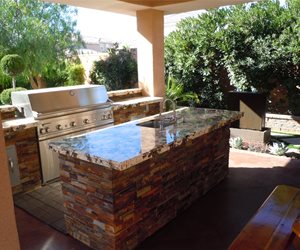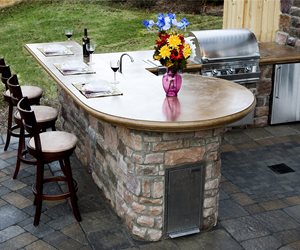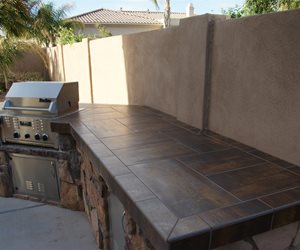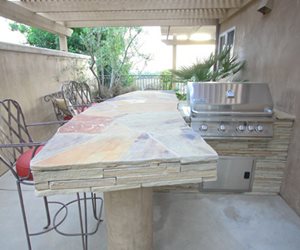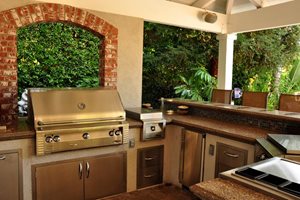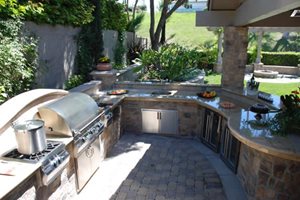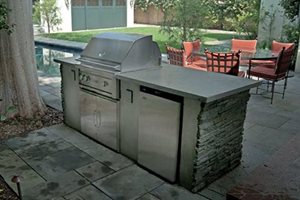Outdoor Kitchen Countertops
Compare popular outdoor barbecue counter materialsOutdoor countertops are a great amenity if you plan to do a lot of cooking and entertaining outdoors. Consider installing enough counter space for food prep and serving areas. Outdoor kitchen counters are typically installed at a height of 36”, which is the same as indoors. However, if you want guests to be able to socialize with the cook, a split-level counter with the raised portion at bar height (42”) is especially nice. To accommodate the grill, outdoor countertops tend to be deeper than what you may be used to indoors. Typically, the depth is between 30-36” as opposed to 24” indoors.
Picking a countertop material for your outdoor kitchen is an important decision since it will be constantly exposed to the elements. An outdoor countertop needs to be durable, weather resistant, easy to clean and beautiful. There are nearly as many material choices for outdoor counters as there are for indoor ones. Options include granite, concrete, tile and more. Avoid manufactured countertop materials such as quartz and Corian because they are not designed to resist fading when exposed to UV rays. Keep these requirements in mind when selecting one of the following countertop materials.
Granite
“Granite countertops strengthen the relationship between the interior and exterior by bringing indoor luxuries and comforts to the backyard," says Drew Sivgals of AMS Landscape Design Studios in Newport Beach, CA.
Pros: Luxury indoor look, easy to clean, durable, heat-resistant, nearly seamless
Cons: High cost, very heavy, can develop grease or wine stains, must be cut with special tools
Ideas
- Save money by purchasing pre-cut slabs of granite and designing your kitchen around these
- Select the same granite as your indoor kitchen to strengthen the indoor-outdoor relationship
- Avoid darker colors that will absorb heat and become very hot to the touch
Installation: Granite slabs are cut to size offsite, delivered and installed by a crew capable of heavy lifting. If multiple pieces need to be fit together, the seams will have to be filled.
Check out a backyard sports bar complete with granite countertops.
Other types of stone are available in slab form, including bluestone, travertine and limestone, can be used for outdoor countertops. See an outdoor kitchen with bluestone countertops.
Concrete
“Concrete makes for a very resilient counter that's difficult to stain and easy to clean up,” says Scott Cohen of The Green Scene in Northridge, CA.
Pros: Durable, easy to maintain, limitless design options, can be cast in any shape, smooth surface
Cons: May crack due to improper pouring or installation, requires sealing
Ideas
- Embed recycled glass in the counters to produce a sparkly effect in sunlight
- Add fiber optic lighting to make your countertops come to life at night
- Have personal artifacts cast into the surface of the countertop
- Use a special edge form that will create a rope detail or other interesting look
Installation:Typically the concrete is cast-in-place, allowed to cure and then honed and polished.
See how concrete countertops were used in this small outdoor kitchen design.
Tile
If you are looking for a more economical option, ceramic or porcelain tiles can be used to create an outdoor countertop. Be sure to use a tile that is rated for outdoor use.
Pros: Affordable, easy to clean, many color options
Cons: Grout can become yellow outdoors, grout may stain or crack
Ideas
- Select a dark colored grout that won’t yellow or show stains
- Reduce the number of grout lines by using large 16” tiles
- Use a contrasting or decorative tile for the backsplash to create interest
Installation: Tiles will be attached to cement backer board with thin-set mortar. Then grout will be spread in the joints and sealed after curing.
Check out a picture gallery of ways to use mosaic tile outdoors.
Flagstone
Using flagstone for your outdoor kitchen countertops will create a uniquely rustic appearance. However, there are also downsides. “Flagstone is a very porous material. It's very hard to keep clean. It feels dusty all the time. It sloughs off layers over time, and it's real easy to stain and difficult to seal,” says Scott Cohen of The Green Scene in Northridge, CA.
Pros: rustic and natural look, low cost, proven outdoor material
Cons: stains easily, shaling occurs over time
Installation: A flagstone counter will be installed in a similar fashion to tile: mortar in place, add grout to the joints and seal.
Learn more: What is Flagstone?

 Backyards
Backyards
 Front Yards
Front Yards
